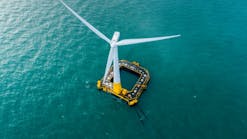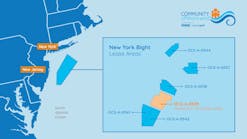Editor's note: This story first appeared in the September-October 2022 issue of Offshore magazine's first annual Offshore Wind Special Report. Click here to view the full Offshore issue or click here to view the special report.
By Jaidev Dhavle, Francisco Boshell and Roland Roesch, International Renewable Energy Agency (IRENA)
The international community remains egregiously far in realizing the climate goals in the 2015 Paris Agreement, and to meet these commitments a profound transformation in the global energy landscape will need to be mandated. This transformation will only be possible with the rapid deployment of low-carbon technologies replacing conventional fossil fuel generation and uses.
Offshore renewables are emerging as a key energy resource to support this rapid energy transition. The benefits of offshore renewables go beyond the energy sector as they have a demonstrated potential to drive a vigorous global blue economy for a variety of end-use applications, including shipping, cooling, aquaculture and water desalination, among others. Offshore renewables are expected to provide significant socioeconomic benefits and to improve the livelihoods through job creation, local value chains and enhanced synergies among the different blue economy actors.
Among offshore renewables, offshore wind power is the most mature technology and is already commercialized. Furthermore, offshore wind has a major role in the energy transition being the only variable renewable baseload technology.
According to IRENA, the cumulative installed capacity of offshore wind increased more than 11-fold between 2010 and 2021, from 3.1 GW to 55.7 GW. The leading market driver has been Europe, but recently China is rapidly picking up with about 17.4 GW of additional capacity installed in just 2021.
To meet a 1.5 C Paris Agreement aligned scenario, IRENA’s analysis indicates that global cumulative capacity of offshore wind would need to reach 380 GW in 2030 and 2,000 GW in 2050. This translates to a required annual installations of 70 GW per year, which is close to the total electricity generation capacity of a country like Indonesia, and annual investments of US$150 billion to 200 billion per year, a value that is in the order of the total GDP of a country like Greece. These projections indicate the magnitude of the challenge ahead to upscale offshore wind deployment, but also the business opportunities for the wind sector.
In 2021 offshore wind continued to enhance its cost competitiveness. The global weighted average levelized cost of electricity (LCOE) of offshore wind has declined by 60% between 2010 and 2021, from $0.188/kilowatt hour (kWh) to $0.075/kWh.
In 2021 alone, there was an 13% reduction year on year. According to IRENA’s latest Renewable Energy Cost Report, Denmark had the lowest weighted average LCOE for projects commissioned in 2021, at $0.041/kWh. The UK had the second lowest weighted average LCOE at $0.054.
While there have been positive trends in the offshore development market, there are important challenges faced by the offshore wind industry. One particularly impactful in the last couple of years concerns supply chain disruptions and increases in transportation and materials costs. According to IRENA’s latest analysis, higher materials prices contributed to a $145/kW increase in materials costs for the wind turbine. This was 65% up on the materials costs in 2020, which was a year marked by low commodity prices. Wind turbine manufacturers’ margins were therefore squeezed in 2021, as their ability to pass through cost increases was limited.
Looking to the future, there will also be an expected increase in the demand for critical materials such as copper, nickel, neodymium and dysprosium, which are key components in generators of wind turbines.
Another major challenge is the long timelines for granting permits to offshore wind projects longer than five years. A positive development to address this issue is the EU Go-To areas approach, where projects will need to be permitted within one year backed up by national governments' strategic environmental assessments. The offshore wind sector also needs to tackle inclusion in national marine spatial planning, the lack of a relevant skill force and foster stronger regional and international collaboration initiatives.
Moving forward, to support catalyzation of offshore wind initiatives, IRENA will be expanding the work of its 70 member Collaborative Framework on Offshore Renewables and Ocean Energy to overcome the hindrances for the offshore wind deployment. The Collaborative Framework also cooperates with other multilateral agendas, as the Offshore Renewables Action Agenda developed by request from the G20 in 2021.
Finally, on a more international and public scale, IRENA, together with Denmark and the Global Wind Energy Council, will be launching at the COP27 the Global Offshore Wind Alliance (GOWA). GOWA intends to have a significant role in convening governments and industry to address these issues directly, sharing best practices for overcoming obstacles. The aim of GOWA in line with IRENA´s calculations is to contribute to achieving a total global offshore wind capacity of 380 GW by 2030, 35 GW each year across the 2020s and a minimum of 70 GW each year from 2030.
Offshore wind, along with other renewables, can support the international community to phase out fossil fuels and have proven to reduce the average electricity system costs as well as lessen the damaging impacts of high electricity prices on consumers and industry. The ongoing fossil fuel price crisis demands a response; renewables and energy efficiency provide the answer, bringing unprecedented benefits for consumers, the environment and the global economy.
References available upon request.









